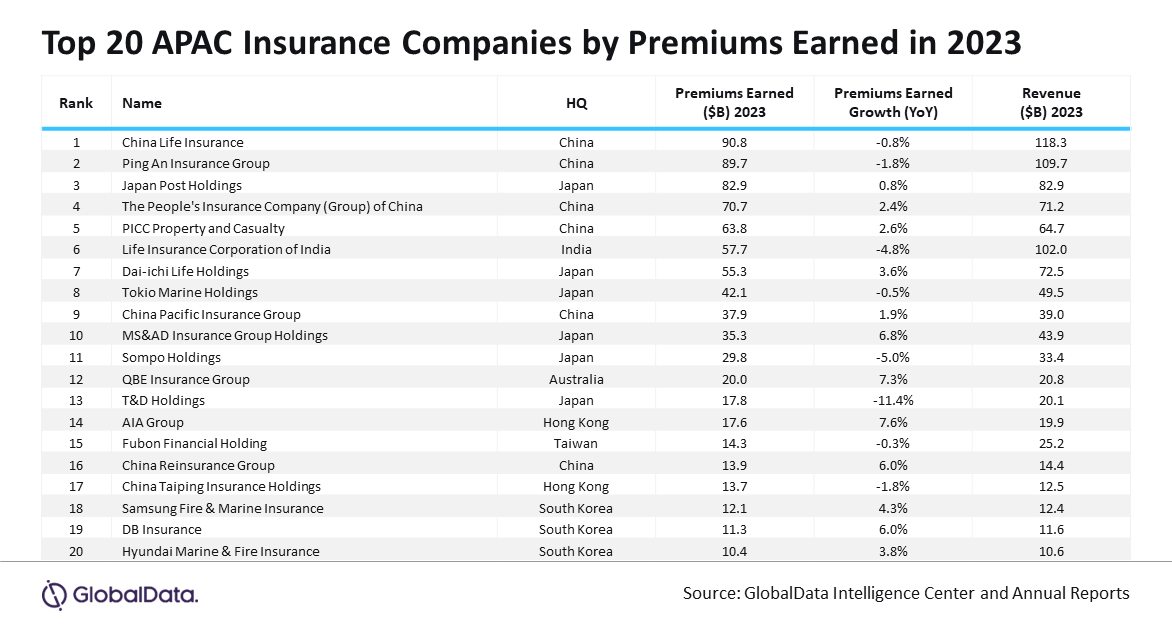

Insurance companies across the Asia-Pacific (APAC) region saw limited premium growth in 2023, with the top 20 publicly listed insurers reporting an average increase of just 1.3%, according to GlobalData, a data analytics firm.
Broader economic challenges, including inflation and the adoption of the new International Financial Reporting Standard (IFRS 17), played a role in constraining growth. At the same time, overall revenue for these companies increased by 5.5%.
GlobalData said the implementation of IFRS 17 has introduced additional complexity in financial reporting, particularly affecting capital requirements.
“The new accounting standard has increased complexity, changed financial reporting, and affected capital requirements,” said Murthy Grandhi, company profiles analyst at GlobalData.
On the bright side, these changes have improved transparency, risk management, and comparability, according to GlobalData.

AIA experienced a 7.6% increase in premium earnings.
This growth was attributed to a strategic shift in its product offerings, focusing more on long-term savings products and an increased contribution from its bancassurance operations in Mainland China.
QBE’s revenue grew by 10.2% in 2023, largely driven by higher premium rates and growth in targeted new business.
However, this was partially offset by its deliberate exit from property portfolios in North America and Australia, as well as a reduction in its exposure to other property lines.
MS&AD reported a 17.5% revenue increase, fuelled by a 4.2% growth from Mitsui Sumitomo Insurance Co and a 2% rise in revenue from Mitsui Direct General Insurance, both boosted by higher premium rates.
Conversely, T&D Holdings and Sompo Holdings saw their premiums decline by 11.4% and 5%, respectively, largely due to stricter underwriting standards, particularly in regions more prone to natural disasters.
Grandhi said that insurers in the APAC region continue to face a challenging landscape.
Economic uncertainty and evolving regulatory frameworks mean insurers must remain flexible to capitalise on growth opportunities, particularly in areas like health and retirement insurance.
Grandhi also highlighted emerging risks related to electric vehicles (EVs) and cyber threats.
“Firms that can balance the demands of risk management with the pursuit of profitable growth, particularly in emerging markets, will be well-positioned to thrive in the years ahead,” he said.
The report further emphasised the role of climate change, which is driving changes in underwriting and pricing, while artificial intelligence (AI) is presenting new opportunities for operational efficiency and business development.
Despite the challenges, the insurance market in APAC continues to show room for growth, especially in areas where insurance penetration remains low.
Globally, the insurance industry maintained its growth momentum in 2023, according to GlobalData.
The top 20 global insurers recorded a 6.2% rise in premiums earned, driven by greater awareness of insurance products and economic recovery in key markets. Total revenue for these companies also rose by 7.8%.
Companies like Progressive Corporation, UnitedHealth Group, and Humana were among the top performers.
Grandhi noted that the global insurance market faces ongoing challenges, including geopolitical fragmentation, economic instability, and the rising frequency of natural disasters. These factors, along with the increasing adoption of AI and emerging technologies, are reshaping the industry landscape.
